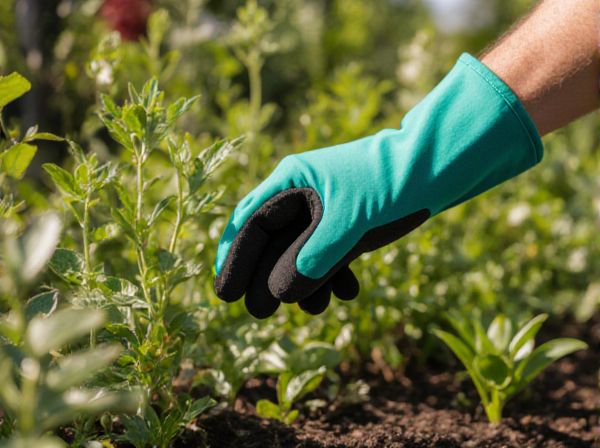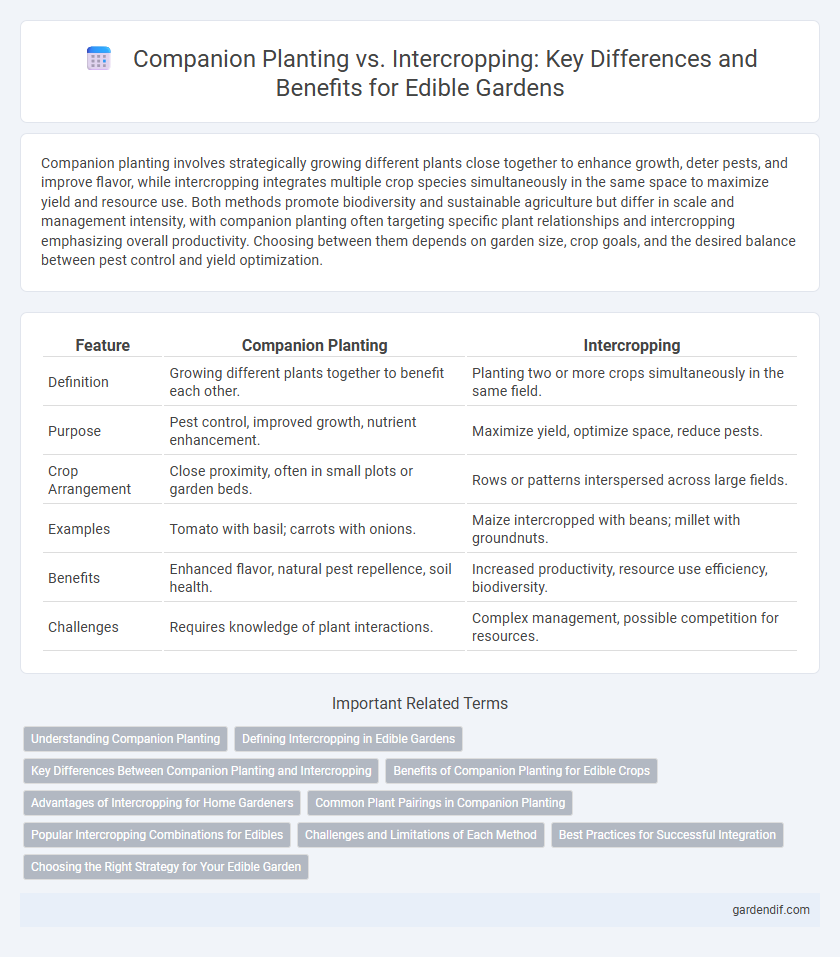
Companion planting vs Intercropping Illustration
Companion planting involves strategically growing different plants close together to enhance growth, deter pests, and improve flavor, while intercropping integrates multiple crop species simultaneously in the same space to maximize yield and resource use. Both methods promote biodiversity and sustainable agriculture but differ in scale and management intensity, with companion planting often targeting specific plant relationships and intercropping emphasizing overall productivity. Choosing between them depends on garden size, crop goals, and the desired balance between pest control and yield optimization.
Table of Comparison
| Feature | Companion Planting | Intercropping |
|---|---|---|
| Definition | Growing different plants together to benefit each other. | Planting two or more crops simultaneously in the same field. |
| Purpose | Pest control, improved growth, nutrient enhancement. | Maximize yield, optimize space, reduce pests. |
| Crop Arrangement | Close proximity, often in small plots or garden beds. | Rows or patterns interspersed across large fields. |
| Examples | Tomato with basil; carrots with onions. | Maize intercropped with beans; millet with groundnuts. |
| Benefits | Enhanced flavor, natural pest repellence, soil health. | Increased productivity, resource use efficiency, biodiversity. |
| Challenges | Requires knowledge of plant interactions. | Complex management, possible competition for resources. |
Understanding Companion Planting
Companion planting involves growing specific plants together to enhance growth, deter pests, and improve crop yield through natural symbiotic relationships. This technique relies on plant compatibility, such as pairing nitrogen-fixing legumes with nutrient-demanding vegetables to optimize soil fertility. Understanding companion planting helps gardeners and farmers create sustainable ecosystems that minimize chemical inputs and promote healthy plant development.
Defining Intercropping in Edible Gardens
Intercropping in edible gardens involves planting two or more crop species simultaneously within the same space to maximize yield, improve soil health, and reduce pests naturally. This method enhances biodiversity by utilizing plant combinations that complement each other's growth habits and nutrient requirements. Intercropping strategies often include mixing root, leaf, and fruit crops to optimize resource use and promote sustainable garden ecosystems.
Key Differences Between Companion Planting and Intercropping
Companion planting involves growing specific plant species together to naturally enhance growth, deter pests, and improve yield by leveraging beneficial plant interactions. Intercropping focuses on cultivating two or more crops in proximity, optimizing space and resource use to maximize overall productivity and reduce risk. The key difference lies in companion planting's emphasis on symbiotic relationships for mutual benefits, while intercropping prioritizes efficient land use and crop diversification.
Benefits of Companion Planting for Edible Crops
Companion planting enhances edible crop yields by promoting natural pest control and improving soil nutrient availability through complementary plant interactions. It reduces the need for chemical fertilizers and pesticides, leading to healthier produce and sustainable gardening practices. Diverse plant combinations, such as pairing legumes with leafy greens, boost overall plant health and increase crop resilience against diseases.
Advantages of Intercropping for Home Gardeners
Intercropping enhances biodiversity in home gardens, leading to improved pest control and soil fertility through diverse root structures and nutrient usage. It maximizes space efficiency by allowing multiple crops to grow simultaneously, increasing overall yield per square foot. This method also reduces the risk of total crop failure by diversifying plant species, which promotes resilience against diseases and changing weather conditions.
Common Plant Pairings in Companion Planting
Common plant pairings in companion planting include tomatoes with basil, which enhances flavor and deters pests, and corn paired with beans and squash, known as the Three Sisters, which optimizes space and nutrient use. Marigolds planted alongside cucumbers repel nematodes, while carrots benefit from being near onions to reduce pest infestations. These strategic combinations promote healthier growth and increased yields without chemical inputs.
Popular Intercropping Combinations for Edibles
Popular intercropping combinations for edibles include tomato with basil, corn with beans and squash, and carrots with onions. These pairings optimize space, enhance nutrient uptake, and naturally repel pests, improving overall crop yield and health. Incorporating diverse plant species in close proximity supports sustainable gardening practices and maximizes harvest efficiency.
Challenges and Limitations of Each Method
Companion planting faces challenges like unpredictable plant interactions and potential competition for nutrients, which can limit crop yield and complicate garden planning. Intercropping involves complex management due to spatial and temporal crop arrangements, often requiring more labor and knowledge to optimize plant combinations effectively. Both methods risk pest and disease transmission if incompatible species are planted too closely, reducing overall productivity.
Best Practices for Successful Integration
Companion planting and intercropping both enhance crop health and yield by strategically combining plant species, yet best practices differ in spacing and plant compatibility. Companion planting thrives with mutually beneficial pairs like tomatoes and basil, optimizing pest control and nutrient exchange, while intercropping benefits from diverse crop arrangements that maximize land use, such as maize with beans. Successful integration requires understanding plant growth cycles, nutrient needs, and pest relationships, ensuring adequate sunlight and soil fertility management to prevent competition and promote symbiotic growth.
Choosing the Right Strategy for Your Edible Garden
Companion planting enhances garden health by pairing plants with complementary traits, such as basil and tomatoes to improve flavor and deter pests, making it ideal for small-scale edible gardens. Intercropping involves growing multiple crops simultaneously in the same space, optimizing land use, boosting biodiversity, and reducing disease risk, which suits larger or intensive garden setups. Selecting the right strategy depends on your garden size, crop variety, and pest management goals to maximize yield and sustainability.
Companion planting vs Intercropping Infographic

 gardendif.com
gardendif.com